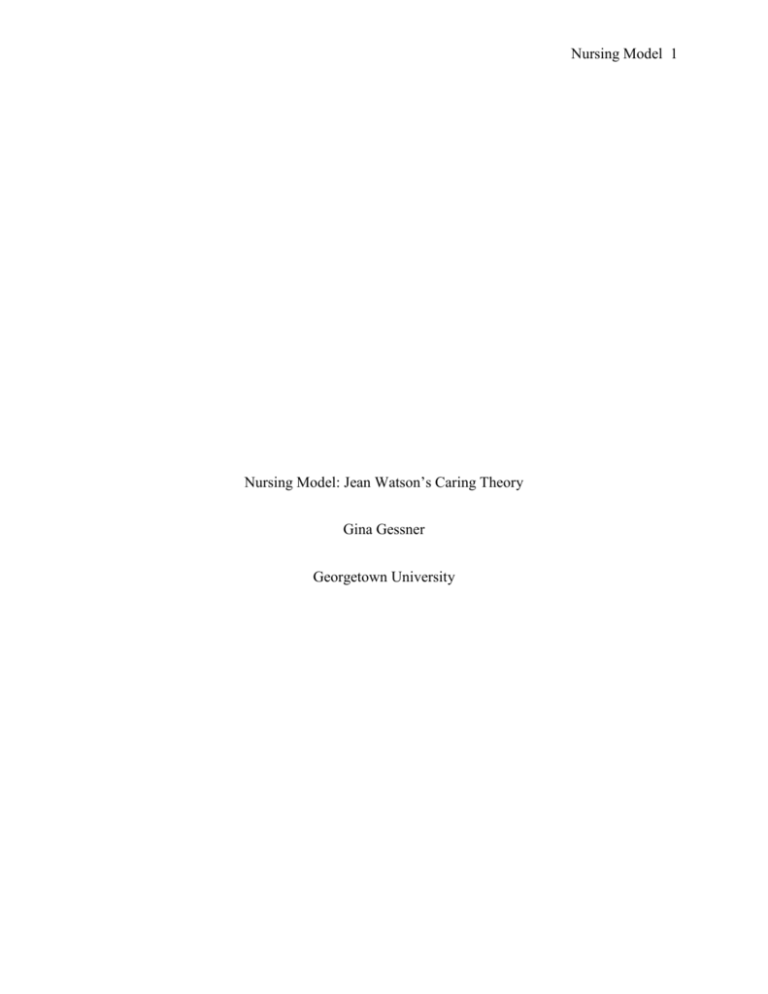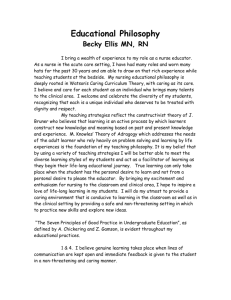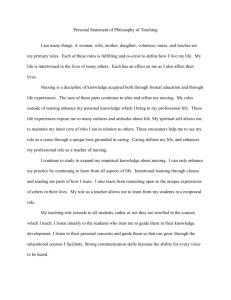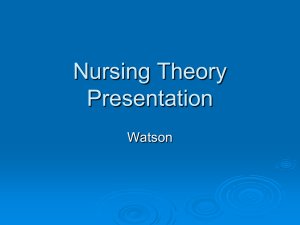
Nursing Model 1
Nursing Model: Jean Watson’s Caring Theory
Gina Gessner
Georgetown University
Nursing Model 2
Watson’s model of caring was developed originally in the 1970’s and amended many
times to the postmodern transpersonal caring-healing paradigm (1999) which is applicable to the
practice of nursing and other disciplines (Fitzpatrick & Whall, 2005) . Watson believes that
many concepts identified by Florence Nightingale and other leaders in nursing are still valid to
modern clinicians and has adopted these traditional concepts into her caring model. Such themes
include, “the view of the human as a valued person in and of him-or herself to be cared for,
respected, nurtured, understood and assisted” as well as, “an emphasis on human-to-human care
transaction between the nurse and person.” Fitzpatrick and Whall also explain that Watson
believes both client and practitioner are to actively participate in healing and caring by,
“experiencing the quantum energy fields conducive to healing from a spiritual, mystical
environment” (2005, p. 297). Many of her concepts have a spiritual element that affects both the
nurse and the client, allowing them to connect deeply and transcend the moment (Fitzpatrick &
Whall, 2005).
Watson’s model can best be described in terms of the nursing metaparadigm. When
describing nursing, Watson proclaims that caring is the “moral ideal” (1988, p.54). She explains
that contact between two human beings can help the ill discover new knowledge that will assist
with recovery and promote harmony. The nurse is involved in a partnership with the patient in
the caring process in which the goal is intersubjectivity. Watson explains that because nursing is
a human science, there are important moral, spiritual and metaphysical components and we can
use our spirits to relate to others (Watson, 1988). In describing the person, Watson believes that
the person has three elements within them which are the mind, body and soul, all of which are
influenced by the self. A person is both a physical being and a spiritual being, with an individual
experience and existence. She describes a person as, “the experiencing or perceiving organism.
Nursing Model 3
The person and the self are the same when the person is congruent with the real self. That occurs
when there is harmony in the mind, body and soul of the person” (Watson, 1988, p.55). The
previous sentiment about harmony between all three aspects of person can be used to describe
health. Health also encompasses unity of the self with others and the environment (Fitzpatrick &
Whall, 2005). Health and the client’s perceived sense of health must be in balance as well for
true health to exist (Watson, 1988). Her original definition of health was based on the World
Health Organization’s model which and then transformed into a more unconventional and
spirituality influenced as the model developed (Fitzpatrick & Whall, 2005). Watson discusses
environment in more abstract terms. Environments should be transformative in nature. She
believes that caring and healing must be able take place in an environment that the nurse helps
create. The nurse helps regulate the environment, making sure all factors for healing are present,
such as support, protection and spirituality (Fitzpatrick & Whall, 2005).
Watson describes ten central components called “carative factors” that serve as the basis
of her theory. These carative factors transcend many of the traditional ideas of nursing yet evoke
the dogma of Nightingale (Fitzpatrick & Whall, 2005). Major points of the carative factors
include altruism, love, trust, creativity, teaching, and spirituality (Watson, 1988). The factors
can be used as an entry way into the theory and be built upon to comprehend more philosophical
and complex themes. It is evident that these carative factors influence her beliefs on all aspects
of the nursing metaparadigm.
Watson’s model of caring supports the huge paradigm shift in the field of nursing. The
curriculum revolution, as it has been called, has focused on departing from the conventional
behaviorist and medical model to one rooted in humanistic values with caring as its central focus.
Bevis states, “Nursing has a social mandate toward shaping a healthcare system that is more
Nursing Model 4
efficacious, just, equitable and caring” (1993, p. 56). Many scholars support this shift and
Watson’s model that embodies caring, transpersonal relationships and spirituality fits well within
this newer set of beliefs. Interestingly, caring is far from a new concept. While it may be
traditional it is also unique to the field of nursing, and many educators and experts believe it is an
essential component to the curriculum. Integrating caring into curriculum is especially important
in today’s healthcare environment, where high patient acuity and technological advances threaten
the sacredness of the nurse patient relationship (Watson, 2009). When a college or university
adopts Watson’s theory as a framework, a nursing student obtains an education that has caring
central to all aspects of the curriculum. Therefore, her model and concepts within the model are
used in many nursing curriculums today.
If one is to explore educational philosophies of nursing schools, almost all make some
reference to caring. Not surprisingly, the caring model has been used at the University of
Colorado where Watson serves as professor. The College’s values include the belief that,
“Nursing is a theory-guided, evidence-based practice, focused on holistic, relationship-centered
caring that facilitates health and healing”
(http://www.ucdenver.edu/academics/colleges/nursing/about-us/deansoffice/Pages/philosophy.aspx). Certain Universities have used Dr. Watson’s caring model as an
influence and formed their own theories based on her core beliefs, such as Watson did with
Rogers. At the Catholic University of America, Dr. Duffy created the Quality Caring Model. It
is described as a, “mid-range theory reflect[ing] nursing's unique role within a multidisciplinary
health care system and places caring relationships at the center of nurses' work”
(http://nursing.cua.edu/qualitycaring/). Similar to Watson’s beliefs, this theory places
Nursing Model 5
importance on relationships and the interaction between the patient and nurse where caring can
occur and is paramount.
A multitude of studies have been performed nationally and worldwide focused on the
integration of caring into the nursing curriculum. For example, a study by Sawatzky, et. al.,
aimed to show that a caring model can also be applied to nursing education as well as patient
care. She argues that one’s teaching philosophy should be intertwined with one’s own nursing
philosophy, and caring is at the root of nursing (Sawatzky, et. al, 2009). In Watson’s caring
model, she emphasizes the importance of the nurse – client relationship. She identifies the agent
of change in the healing process as an “intersubjective interdependent process wherein both
persons may transcend self and usual experiences” (Watson, 1988, p.70). Nursing researchers
claim that this personal relationship applied to the client and nurse also applied to student teacher
interactions (Sawatzky, et. al., 2009). The study also suggests that the nurse educator with a
strong caring ethic should serve as a role model for the student. As a result, their beliefs will
pervade all aspects of the curriculum and the student will learn similar values (Sawatzky, et. al.,
2009). Cook and Cullen studied the restructuring of an associate degree nursing program using
Watson’s caring model (2003). The program specificities were adequately described and could
be easily replicated by an institution. This study used the carative factors as an introductory
method to help students begin to understand about caring. Later, students used the factors to
help identify clients’ needs and analyze the incorporation of caring into patient care focusing on
the more complex and abstract definitions of caring (Cook & Cullen, 2003).
According to certain supporters of the caring curriculum shift, behaviorist values stifle
creativity and do not facilitate critical thinking (Bevis, 1993). Using a framework such as
Nursing Model 6
Watson’s to build a curriculum helps interject themes of caring and altruism into content based
courses, which helps reinforce the importance of adoption and implementation of such values in
patient interactions. Adopting a caring model into ones curriculum must have educators whom
also share this philosophy and use caring in their practice. It is postulated that students learn
caring by modeling so it is especially important that faculty members treat students respectfully,
feel good about themselves and confident in their teaching roles (Bauer, 1990). Additionally, in
a clinical setting, students observe caring interactions and learn from experiencing faculty
interactions with patients (Cook & Cullen, 2003).
The humanistic philosophy at its core emphasizes the respect and love for all human
beings (Billings & Halstead, 2009). This concept of altruism is clear throughout Watson’s caring
model. In her caritas processes a, “humanistic-altruistic system of values” is the first concept
listed (Watson, 1988). Watson believes that caring is a moral commitment to humanity that can
spiritually benefit the nurse as well as the welfare of others (Watson, 1988). Both Watson and
Nightingale believe in a “calling” that brings people to the profession of nursing. This sense of
calling is rooted in love and reverence for all human beings (Watson, 1988).
Watson was influenced by Carl Rogers, one of the innovators of the humanistic approach
to psychology. Like Rogers, Watson believed that one must have a harmony and balance within
oneself to be capable of knowing and caring for another (Fitzpatrick & Whall, 2005). Much of
her beliefs about the “transpersonal relationship” have been influenced by Rogers as well. The
transpersonal relationship requires both the nurse and client to explore their own beliefs within
themselves in order to maximize their experience as a human being. Watson believes that, “selfknowing is the foundation for loving and accepting the human experience of others” (Fitzpatrick
Nursing Model 7
& Whall, 2005, p.313). In humanism, the ultimate goal is to treat other human beings with
dignity and respect. This goal could be considered equitable to the definition of caring.
One could easily compare the relationship between the student and teacher in the
humanistic educational philosophy with the nurse – client relationship in Watson’s model. When
utilizing a humanistic educational philosophy, the teacher serves at the facilitator of learning,
rather than adopting an authoritarian position (Billings & Halstead, 2009). The relationship
between the teacher and student could be described as a partnership. Learning occurs primarily
within the student and the teacher’s goal is to assist the student on the journey where learning
can occur. The student serves as the agent of change, and the teacher supports the student in
maximizing their potential. The relationship between student and teacher is more egalitarian and
collaborative in nature, compared to traditional paradigms. When describing nurse client
relationships, the nurse similarly is a collaborator in the healing process and helps promote
positive change within the patient (Fitzpatrick & Whall, 2005). The nurse aims to promote
autonomy and freedom of choice in client interactions (Fitzpatrick & Whall, 2005). When a
caring relationship occurs, it allows the client can move towards a more enlightened self
(Watson, 1988). Both the teacher and the nurse’s ultimate goal is the formation of a
collaborative relationship in which change can occur.
Self actualization is a common theme in both the theory and humanistic philosophy.
Humanists believe that self-actualization is an important to achieve in one’s life. Maslow
describes self actualization as the desire to reach ones full potential, synonymous with self –
fulfillment (Maslow, 1943). Once basic, essential needs are met, the person strives to achieve
what they are meant to do, thus becoming self-actualized (Maslow, 1943). In a transpersonal
relationship between the nurse and client, “focuses our self-development and expression on
Nursing Model 8
deeper, more spiritual, even cosmic concerns than emanate from the personal and
intersubjective” (Watson, 1994, p.5). When the nurse is active in the caring process and utilizes
the carative factors, self actualization and heightened levels of consciousness can be achieved
(Fitzpatrick & Whall, 2005). In this relationship, the nurse must explore her own beliefs and try
to embrace the caring processes which can result in actualization of her own spirit (Fitzpatrick &
Whall, 2005). In addition to the nurse achieving self actualization, the primary goal is
facilitation of self actualization in the client. She states, “The goal of nursing proposed is to help
persons gain a higher degree of harmony within the mind, body, and soul which generates selfknowledge, self-reverence, self-healing, and self care processes while allowing increasing
diversity” (Watson, 1988, p.49). By assisting clients in finding meaning behind their illness, the
nurse aids in the achievement of self-actualization while often achieving it herself as a secondary
response.
In Watson’s model, there is perhaps more emphasis on spirituality and mysticism than in
the humanistic paradigm. Watson speaks much of the transpersonal relationship which occurs
with human to human interaction. She states, “if the caring moment is transpersonal, each feels
a connection with the other at the spirit level, thus it transcends time and space” (Watson, 1985,
p.157). When educating students in the humanistic philosophy, students are often asked to
engage in self-reflection of experiences in order to extract meaning (Billings & Halstead, 2009).
Perhaps this could be considered spiritual in nature; however it seems that the concept of
spirituality is most apparent in Watson’s theory, with more emphasis on cosmic and mystical
effects.
The caring model has been criticized for language that is abstract and vague. The
semantic consistency has been compromised due to the evolution and republications of the
Nursing Model 9
theory (Fitzpatrick & Whall, 2005). Watson has borrowed components from philosophy,
spirituality and mysticism, and existentialism which cause difficulty for the reader to abstract
meaning from her works (Fitzpatrick & Whall, 2005). She also references metaphysical and
epistemological concepts, which make those without a background in psychology and
philosophy at a disadvantage for total theory comprehension. Watson’s writing style is not
necessarily concise making it difficult to decipher. For a novice nursing student with only a high
school degree, this could pose a great problem. Students may be easily discouraged by these
factors and although her concepts within the theory are relatively simple, it may be perceived as
too abstract and confusing for curriculum application.
Additionally, critics question the practicality of such a model in today’s healthcare
environment, where the goal of care in many cases is to provide the best quality for the lowest
cost. Nurses may not be able to maintain such personal and spiritual relationships with patients
where acuity levels are high (Fitzpatrick & Whall, 2005). A novice nurse especially may be
misguided by the interwoven caring theme and falsely prioritize emotional needs and thus
neglect basic needs of the patient, such as medication administration and disease management.
Watson however does acknowledge the change in acuity of healthcare today and claims that this
is all the more reason to adopt a caring model in nursing, as this central nursing concept is being
threatened by such an environment (2009).
Watson’s model is most appropriately used to perform descriptive, qualitative,
phenomenologic research (Fitzpatrick & Whall, 2005). This type of research adds to the body of
nursing knowledge and aids nurses in understanding patient experiences. However, nurses must
be able to conduct quantitative research, which is important for the implementation of evidence
based practice. Evidence based practice is an important concern of policy makers and regulatory
Nursing Model 10
agencies and Watson’s model is not adequate in supporting such research methods. The caring
model may neglect to express the responsibility of the nurse to provide for the patients physical
needs, which is a primary role of the nurse as a member of the healthcare team. The model is
well suited for specialties such as palliative care, and oncology where death is imminent and
spiritual experiences and mysticism are high. This model may not work as well in certain areas
such as neurology or the ICU, where many patients are acutely ill, unconscious or heavily
sedated. The student may not find this theory applicable in such care opportunities.
The strengths in Watson’s model lie in its content. This model reminds and reinforces
the nurse to hold caring central to every action and thought while practicing. By utilizing this
framework in a curriculum, nursing students can truly understand the deeper meaning of what it
means to be a nurse, as caring is the essence of nursing. Also, by adopting this model personally
as a framework for care, the nurse can focus on the spiritual rewards that can be gained by
assisting others in the healing process. This is likely to increase the nurse’s perception of the
overarching value of his/her profession which may increase job satisfaction and performance
(Bauer, 1990). By adopting the caring model, nursing can have its own model and basis for
practice that is different from medical and more behaviorist models.
Nursing Model 11
References
Bauer, J. A. (1990). Caring as the central focus in nursing curriculum development. National
League of Nursing, 41, 255-66.
Bevis, E. (1993). Alliance for destiny: education and practice. Nursing Management, 24 (4), 5661.
Billings, D. M., Halstead, J. A. (2009). Teaching in Nursing, a guide for faculty (3rd ed.). St
Louis, MO: Saunders Elsevier.
Cook, P. R., Cullen, J. A. (2003). Caring as an imperative for nursing education. Nursing
Education Perspectives, 24 (4), 192-197.
Fitzpatrick, J. J., Whall, A. L. (2005). Conceptual models of nursing: analysis and application.
Upper Saddle River, New Jersey: Pearson Prentice Hall.
Maslow, A. (1943). A Theory of Human Motivation. Psychological Review, 50, 370-396.
The Catholic University of America (2009). Welcome to the quality-caring model. Retrieved
October 27, 2010, from http://nursing.cua.edu/qualitycaring/
The Regents of the University of Colorado (2008). The Dean’s office educational philosophy
and outcomes. Retrieved Oct 27, 2010, from
http://www.ucdenver.edu/academics/colleges/nursing/about-us/deansoffice/Pages/philosophy.aspx
Watson, J. (1988) Nursing: Human Science and Human Care. New York: National League for
Nursing.
Nursing Model 12
Watson, J. (1985) Nursing: Human Science and human care: A theory of nursing. Norwalk, CT:
Appleton-Century-Crofts.
Watson, J. (2009). Caring science and human caring theory: transforming personal and
professional practices of nursing and healthcare. Journal of Health and Human Services
Administration, 31(4), 466-482.
Sawatzky, J. V., Enns, C. A., Ashcroft, T. J., Davis, P. L., Harder, B. N. (2009) Teaching
excellence in nursing education: a caring framework. Journal of Professional Nursing,
25 (5), 260-266.









